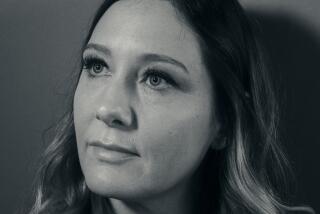Decoding the linguistic geekiness behind âArrivalâsâ sci-fi sheen
[Helpful note: This article assumes a knowledge of, and reveals details from, the plot of âArrival.â Read at your own risk.]
Large-scale Hollywood films employ a wide range of consultants, from ER doctors to military experts to veteran constitutional lawyers.
Rare is the big-budget adventure, however, that retains a linguistâ specializing in syntax, morphology, ergativity and nominalization.
As moviegoers have turned out to see âArrivalâ â Denis Villeneuveâs cerebral alien-invader adventure has grossed $50 million in two weeks of release â many have been struck by the language symbols at its center.
Those ornate, hollowed-out inkblots â like Rorschach tests by way of âE.T.â â have distinguished the film from many science-fiction movies that came before. Very few nonhuman languages have ever been shown on screen in their written form, let alone been made the center of sophisticated in-movie linguistic study.
To ensure the authenticity of the symbols (and the linguists), producers hired Jessica Coon, a McGill University associate professor in syntax and indigenous languages. Coon has spent years as a field worker studying assorted Mayan languages as well as the First Nations language of Miâgmaqâ in Quebec.
That prepared her â sort of â for all that the Heptapods were spraying on about.
âThere was a lot in the script that has to do how we conduct field work to study a language,â Coon said in a phone interview. âBut youâd be surprised by all the emails Iâve been getting â a lot of talk about aliens.â
âArrivalâ centers on Louise Banks (Amy Adams), a top specialist ârecruited by the U.S. government after unidentified aliens known as Heptapods dock their crafts just above 12 global epicenters, including the United States. Louise spends much of the film trying to communicate with the mysterious and only possibly threatening creatures, learning the Heptasâ language and teaching them our own.
The question many of us come away with: How much of a language is this really?
The answer is that it is one â slightly. The inkblots, known as logograms, were primarily devised by the filmâs production design team under Patrice Vermette. There were only about a 100 of them in use during the shoot (they worked off images included in Eric Heissererâs script). So itâs not like the full-blown language of âStar Trekâsâ Klingon or âAvatarâsâ Naâvi, where teams were hired to create complex grammatical structures and a culture of armchair enthusiasts and speakers have sprung up in their wake.
Still, thereâs a consistency to the logograms as theyâre used in âArrivalâ â Coon helped vet them to make sureâ all the curlicues and flourishes matched on repeated uses of the words and concepts. Whatâs more, she âmade sure that Banksâ process for figuring out what they meant looked like that of a person actually studying a new method of communication.
âOne of the big âmisconceptions about linguists is that weâre just people who know and speak and translate languages,â Coon said. âThatâs not what field workers â which is what Amyâs character is â actually do. Weâre interested in the structural properties; weâre interested in understanding what underlies them. There are between six- and seven-thousand languages in the world, and for most weâve only begun to scratch the surface.â (If youâre curious you can read more about Coonâs work, and all that ergativity, here.)
Coon met with Adams before shooting began to explain how she went about her work; she also received a FedEx package of logograms and was told, essentially, mark them up as you would any set of unfamiliar symbols. Coon tackled them as she would a Mayan dialect, scrawling phrases like âannotate nounâ on its sheets and then sending it back to producers. They then incorporated her notes into shots in the film.
The professor says that âArrivalâsâ linguistic ideas are genuine, even if theyâre sometimes outside the bounds of the fieldâs conventional wisdom.
One core idea the movie takes up is the Sapir-Whorf hypothesis, a theory of linguistic relativity that, in its strongest form, argues that language affects thought; an English speaker and Finnish speaker, the hypothesis submits, will think in ways that are fundamentally different.
The theory has generally been discredited in the linguist community. But the movie cleverly finds a way to re-open the argument, asking if the postulate may hold water with nonhuman languages (because nonhumans may think differently than us Earth-bound folks in the first place).
By extension, it also asks if Louise might begin to think differently herself once she learns the Heptapodsâ language, which is how âsheâs able to âuse weaponâ and open up time in the movieâs finale.
While that latter idea is a little more far-fetched, Coon says, the notion of a nonhuman language containing different properties â and thus different thought-processes for its speakers â may be reasonable.
âI donât know if I would go on the record to say a human learning an alien language would have their brain rewired,â Coon said with a slight laugh. âBut what the film leads you to think about is how different [aliensâ] perceptual process might be and how their communication system might differ in corresponding ways. Human language is part of the genetic endowment to humans. Thereâs good reason to think alien language would be different.â
Whether Louise would even be contacted in the first place is another question viewers might have â the idea of high-level military commanders running down Steven Pinker acolytes can at first strain credulity.
But they would, Coon said, because they know a field linguist would be able to map sounds and understand new languages a lot more quickly than anyone else, though she questions the factors that brought them to Louise in the first place. Early in the film, Forest Whitakerâs military commander bursts into the linguistâs office saying sheâs atop the governmentâs list of Farsi experts â a list the government would not have, Coon said, because Farsi is spoken by millions of people.
One key difference between alien and human languages, according to how the former is conceived in the film, is the relationship each civilization maintains between its written and spoken forms. In human languages, spoken and written forms tend to be the same, just delivered differently; we speak English with a series of sounds, and just represent them via letters and words on the page. For the Heptapods, though, thereâs no relationship between spoken and written language.
One manifestation of this: âIn humansâ spoken language, word order is always important (âDean gave Frankâ means something different than âFrank gave Deanâ). When humans write down language they maintain that structure to retain that meaning. But the Heptapodsâ donât need to maintain that order when writing down language; because the logograms represent entire concepts, sequence doesnât matter.
If that sounds like a, well, rather nuanced distinction for a piece of movie-multiplex escapism, it shouldâ. Filmmakers were eager to dive into finer scientific points in making âArrival.â Because the source materialâs novelty came from its authenticity â Heissererâs script is based on Ted Chiangâs meticulously researched short story â the movie, they reasoned, should reflect a similar genuineness.
âIt felt like a great challenge to us â portraying what would they communicate,â said Dan Levine, one of the filmâs producers. âWe wanted this language to be scary yet beautiful, and also linguistically correct.â (Designers did create a âbibleâ that contained more words than were used in the film; if someone you know starts expressing a desire to speak Heptapod beyond whatâs in the movie, you can have them contact producers, or a nearby therapist.)
Heisserer came up with the languageâs circular design, which is of course also key to the movieâs repetitive-time themes. It was Vermetteâs wife who designed its distinctive black, inky look. All of the logograms were CG; the actors never saw them while shooting a scene.
Coon, who is based in Montreal, has often traveled to Chiapas and other âremote parts of Mexico to research Mayan languages. She said her job is rarely as hard as Banksâ is in the film because there usually are bilingual speakers who can translate â itâs a lot easier âto communicate with someone in a language new to each side if you have a go-between who understands both.
Still, with very obscure dialects, Coon and colleagues might need to fly as blind as Louise does. The professor said that establishing a baseline by making connections between sounds and letters on one hand and objects and actions on the other, as Louise does, would essentially be the approach field workers take too. (This method, she cautioned, is not how small children generally learn their first language, with apologies to parents who conduct frequent show-and-tell exercises with their babies.)
If they’d done justice to all that goes into understanding an unknown language, you’d just be watching a series of TED talks.
— Jessica Coon, associate professor in syntax and indigenous languages
Perhaps Coonâs greatest contribution to the film came about unintentionally.
Heissererâs script called for Louise to tell a real-life story to Whitakerâs commander about the origins of the word kangaroo, involving Aboriginal Australians saying âkangarooâ to inquisitive newly arrived British explorers â which in the formerâs language mâeant âI donât know,â leading the explorers to name the hopping animals kangaroos. The scene was to be played straight, with Banks getting the better of the military officer.
There was only one problem, Coon said, after filmmakers brought her the script: The story is a myth.
Producers listened and then, with the pivoting power of any good scientific researcher, came up with a solâution: They would have Banks tell the story anyway, then have her admit afterward to a colleague (Jeremy Renner) that it was bunk. The moment is one of the filmâs biggest laugh lines.
There are, of course, some limits to how closely filmmakers followed linguistsâ work. When Banks is seen trying to piece together the Heptasâ language âby scrutinizing documents, sheâs not doing much of that linguists would, which is likely to involve a lot more materials and the recruitment of colleagues. It also could be the stuff of years, not weeks.
Instead, the depiction of Louise slaving away in an army tent is meant to give a frisson of truth, the way the medical examiner in a primetime procedural slices open a corpse to lend the basic gist of an autopsy.â Actual linguistics isnât just about holding up some flashcards â itâs laborious and not-exactly-cinematic work.
âIf theyâd done justice to all that goes into understanding an unknown language,â Coon said, âyouâd just be watching a series of TED talks.â
See the most-read stories in Entertainment this hour Âť
On Twitter: @ZeitchikLAT
ALSO
Dev Patel and the real familial investigator at the heart of âLionâ
More to Read
Only good movies
Get the Indie Focus newsletter, Mark Olsen's weekly guide to the world of cinema.
You may occasionally receive promotional content from the Los Angeles Times.











